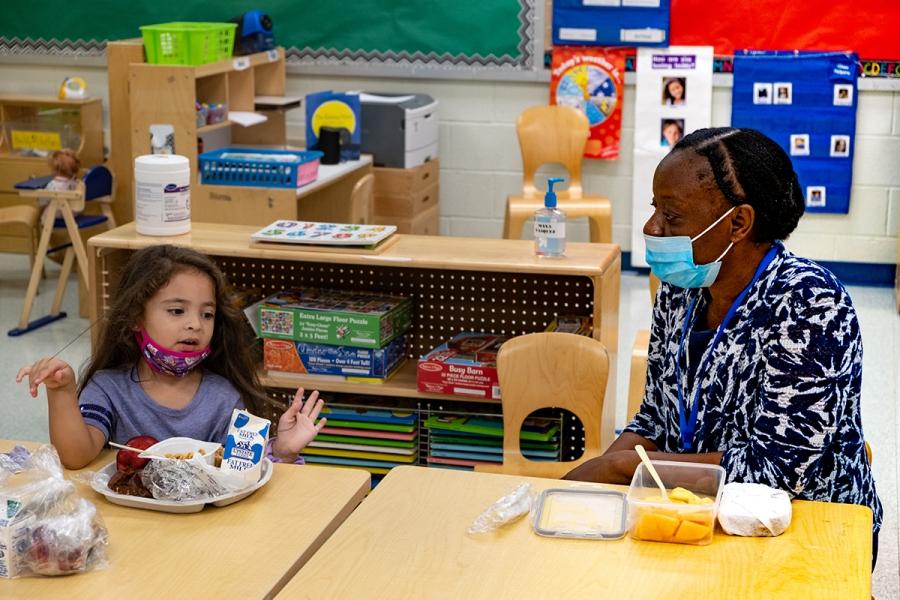Paraprofessionals’ rights and responsibilities during blended learning

The pandemic and the introduction of blended learning this September has resulted in significant changes in the work that paraprofessionals, both in-person and remote, perform. The city Department of Education and the UFT have hammered out guidance that reflects this new reality while protecting paras’ rights.
The school day
Paraprofessionals are not required to stay in the school building for more than 6 hours and 20 minutes per day. They are required to remotely perform the remaining 30 minutes of work, which may be scheduled for the beginning or the end of the school day.
During this 30-minute remote work time, paraprofessionals are expected to support their assigned students, teachers and colleagues, and perform related tasks such as communicating with students and families; participating in remote professional development; and supporting teachers with data collection and by monitoring the progress of remote students.
Paraprofessionals who are asked by a supervisor to work beyond the 6 hours and 20 minutes in person should follow instructions and then inform their chapter leader, who can file an operational issues complaint.
In-person responsibilities
In-person paraprofessionals may be assigned the following tasks when they are not working directly with a specific student or class:
- Assist with arrival and/or dismissal including busing.
- Assist with health screening upon entry.
- Provide student and parent outreach.
- Provide other administrative duties, including, but not limited to, hall duty, cafeteria duty or attendance processing
Responsibilities with remote students
Paraprofessionals can assist in the delivery of instructional activities under the general supervision of the special education teacher.
According to new guidance issued on Dec. 8, paras, at the direction of the teacher, may support individual or small groups of remote students with learning activities, either in a virtual “breakout room” while the teacher is working in the virtual “main room” or helping a student with asynchronous or independent learning activities assigned by the teacher.
Where videoconferencing is deemed appropriate, the para will interact with the remote student in the teacher’s virtual classroom. The teacher does not have to be present in the virtual classroom when the paraprofessional is helping with these independent activities to reinforce skills or help with assignments. With this new responsibility comes additional protection limiting the discipline a para could face without just cause.
A paraprofessional’s role with remote students may also include:
- Assisting with preparing and uploading remote-learning materials during instructional coordination time.
- Facilitating small instructional groups under the direction of the teacher.
- Assisting families and students in accessing remote learning platforms.
- Sharing strategies that have been successful in supporting students’ individual needs.
- Assisting students and families in reinforcing Positive Behavior Support systems.
Safety first
Paraprofessionals, especially 1:1 paras who work closely with one student, should be sure to use all the necessary personal protective equipment for the task they are asked to perform. Paras with questions or concerns should contact the UFT Safety and Health liaison in their borough, listed at www.uft.org/your-rights/safety-health.
A new position for in-person paras
The position of paraprofessional classroom manager was created this fall to meet the demands of the pandemic. The para classroom manager manages classrooms of students, under the general direction of a pedagogue, while the students perform independent work; eat during noninstructional lunch; and/or are being instructed by a remote teacher during synchronous learning. Paras who accept the new position may also be asked to staff isolation rooms in schools.
The position comes with a per-term stipend of $1,750.
Additional guidance
One-on-one paras paired with a fully remote student shouldn’t be assigned any in-person duties. One-on-one paras assigned a blended learning student shouldn’t be assigned in-person duties on days when their student is working remotely.
If a supervisor requests that a para work on site when their student is remote, the para should follow instructions and then contact their chapter leader, who can file an operational issues complaint.
If the teacher is doing parent-teacher conferences remotely, the para should work remotely as well to support the teacher during those conferences.